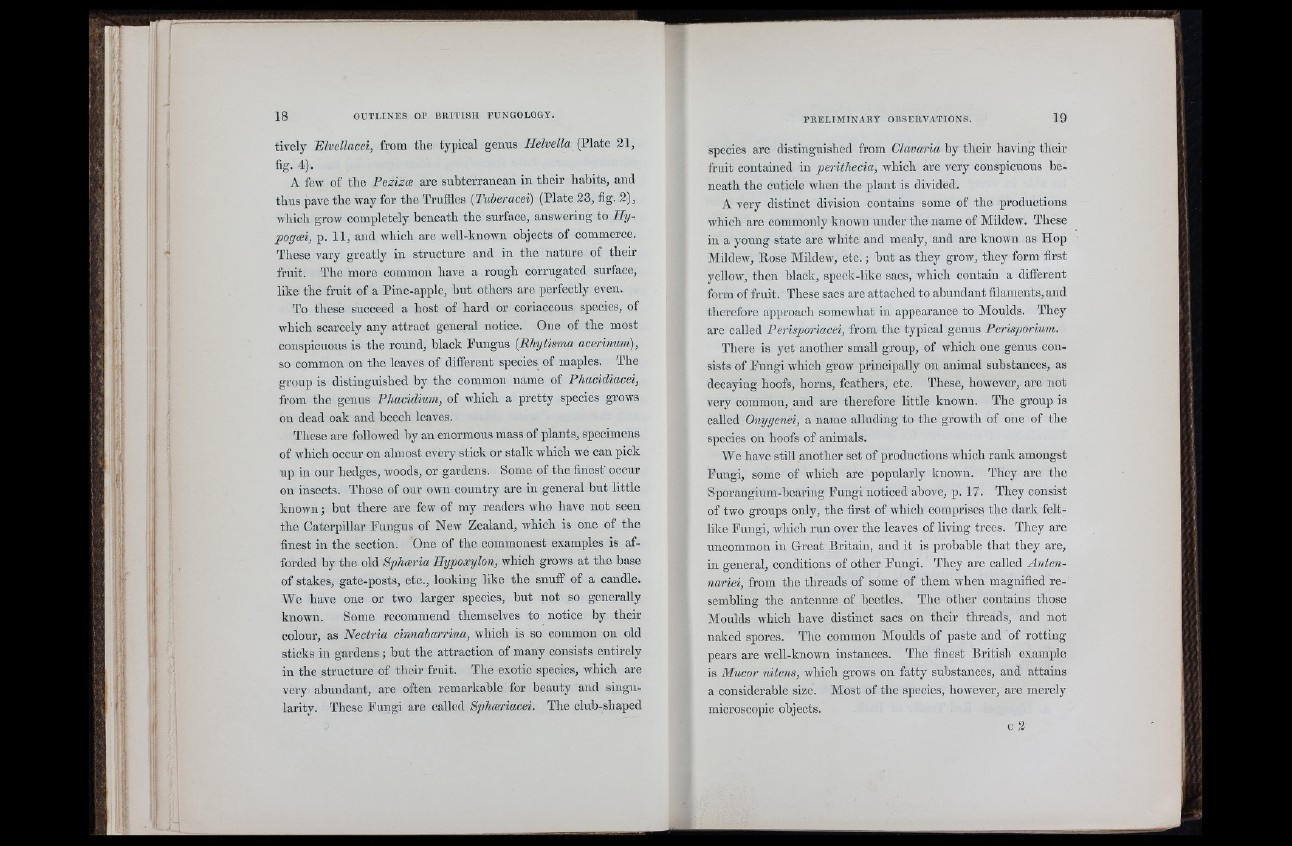
u
tively Elvellacei, from the typical geims Helvella (Plate 31,
fig. 4).
A few of the Pezizoe are subterranean in their habits, and
thus pave the way for the Truffles {Tuberacei) (Plate 23, fig. 2),
which grow completely beneath the surface, answering to Hy-
pogæi, p. 11, and which are well-known objects of commerce.
These vary greatly in structure and in the nature of their
fruit. The more common have a rough corrugated surface,
like the fruit of a Pine-apple, but others arc perfectly even.
To these succeed a host of hard or coriaceous species, of
which scarcely any attract general notice. One of the most
conspicuous is the round, black Fungus {Rhytisma acerinum),
so common on the leaves of different species of maples. The
group is distinguished by the common name of Phacidiacei,
from the genus Phacidium, of which a pretty species grows
on dead oak and beech leaves.
These are followed by an enormous mass of plants, specimens
of which occur on almost every stick or stalk which we can pick
up in our hedges, woods, or gardens. Some of the finest' occur
on insects. Those of our own country are in general hut little
known ; but there are few of my readers who have not seen
the Caterpillar Fungus of New Zealand, which is one of the
finest in the section. One of the commonest examples is afforded
by the old Sphæria Hypoxylon, which grows at the base
of stakes, gate-posts, etc., looking like the snuff of a candle.
We have one or two larger species, hut not so generally
known. Some recommend themselves to notice by their
colour, as Nectria cinnabarrina, which is so common on old
sticks in gardens ; hut the attraction of many consists entirely
in the structure of their fruit. The exotic species, which are
very abundant, arc often remarkable for beauty and singularity.
These Fungi are called Sphæriacei. The club-shaped
species are distinguished from Clavaria by their having their
fruit contained in perithecia, which are very conspicuous beneath
the cuticle when the plant is divided.
A very distinct division contains some of the productions
which are commonly known under the name of Mildew. These
in a young state are white and mealy, and are known as Hop
Mildew, Rose Mildew, etc.; but as they grow, they form first
yellow, then black, speck-like sacs, which contain a different
form of fruit. These sacs are attached to abundant filaments, and
therefore approach somewhat in appearance to Moulds. They
are called Perisporiacei, from the typical genus Perisporium.
There is yet another small group, of which one genus consists
of Fungi which grow principally on animal substances, as
decaying hoofs, horns, feathers, etc. These, however, arc not
very common, and are therefore little known. The group is
called Onygenei, a name alluding to the growth of one of the
species on hoofs of animals.
We have still another set of productions which rank amongst
Fungi, some of which are popularly known. They are the
Sporangium-bearing Fungi noticed above, p. 17. They consist
of two groups only, the first of which comprises the dark feltlike
Fungi, which run over the leaves of living trees. They are
uncommon in Great Britain, and it is probable that they are,
in general, conditions of other Fungi. They are called Anten-
nariei, from the threads of some of them when magnified resembling
the antenna} of beetles. The other contains those
Moulds which have distinct sacs on their threads, and not
naked spores. The common Moulds of paste and of rotting
pears are well-known instances. The finest British example
is Mucor nitens, which grows on fatty substances, and attains
a considerable size. Most of the species, however, are merely
microscopic objects.
c 3
Ü